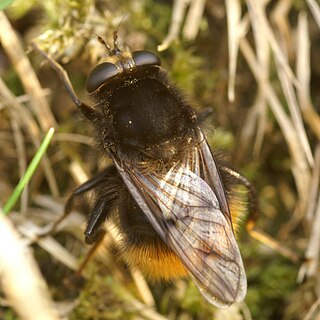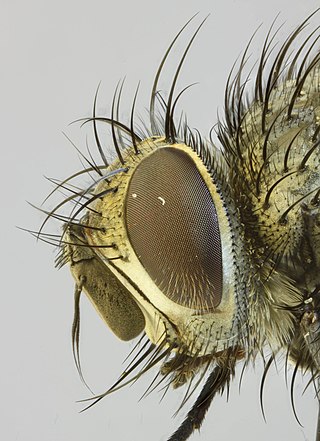
Hover flies of the genus Microdon are unusual among the Diptera. Like other members of the subfamily, they are myrmecophiles, meaning they inhabit the nests of ants.

Mallota is a widely distributed Holarctic genus of hoverfly, well known for their bee-like appearance.

Syritta is a genus of hoverflies, family Syrphidae.

Xylota is a Holarctic genus of hoverflies similar in structure to the related genera Chalcosyrphus and Brachypalpoides. As the larvae are saprophytic they're usually found in rotting wood. The adult flies are generally associated with woodland and woodland edges and can often be seen running over the upper sides of leaves. Unlike other syrphids the adults of many species rarely visit flowers preferring instead to gather pollen from leaf surfaces. There are over 100 described species of which 12 can be found in Europe. Seven species have been recorded in Britain. Identification of species has been difficult and identifiction by photographs is risky.

Spilomyia is a genus of hoverflies. Many species in the genus show Batesian mimicry of wasp models, including black and yellow patterns and modified antenna shape.

Peleteria is a widespread genus of flies in the family Tachinidae.

Lydina is a genus of flies in the family Tachinidae.

Platycheirus is a large genus of hoverflies. They are also called sedgesitters.

Melangyna is a genus of hoverflies.

Blera is primarily a North American genus, though there are 3 species from Europe. The genus is characterized by the following characters:

Chalcosyrphus is a genus of hoverflies in the subfamily Eristalinae. Many species exhibit some degree of mimicry of various sawflies and other hymenopterans and are often brightly coloured or metallic in hue. The adults are similar in structure and behavior to the related genus Xylota but differ in larval morphology. They can be found throughout Europe, Asia, and North America and seem to prefer damper, boggy habitats. The larvae are saproxylic feeders in rotten wood in these habitats.

The Milesiini is a large and diverse tribe of hoverflies. They mimic wasps or hornets.

Copestylum is one of the largest genera of hoverflies in the Americas. It comprises more than 300 species, of which only four have been found outside the Americas, having probably been introduced by the importation of cacti in which the larvae live.

The Syrphini are a tribe of hoverflies.

Criorhina ranunculi, is a species of hoverfly found in the spring in many parts of Britain and Europe.

Macquartia tenebricosa is a European species of fly in the family Tachinidae.

Phryxe nemea is a species of fly in the family Tachinidae.
Palumbia bellieri is a species of hoverfly in the family Syrphidae.
Palumbia eristaloides is a species of hoverfly in the family Syrphidae.
Palumbia inflata is a species of hoverfly in the family Syrphidae.
















